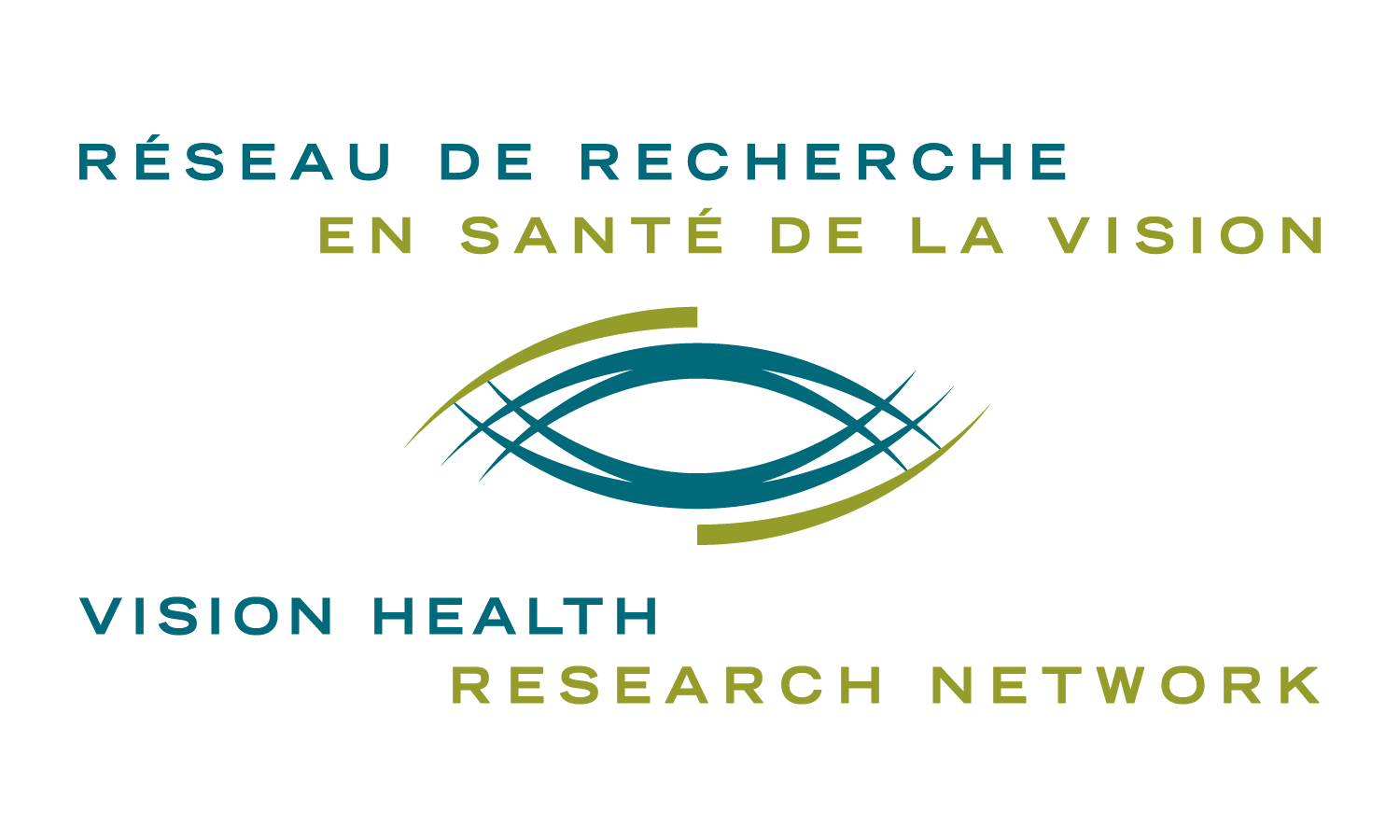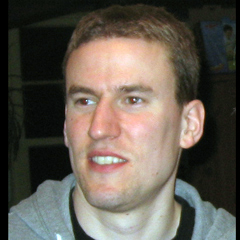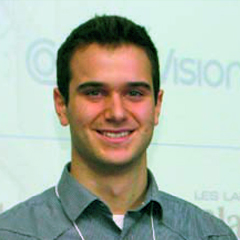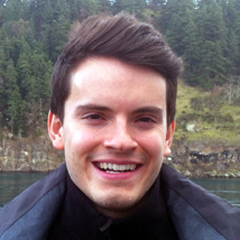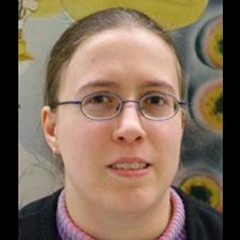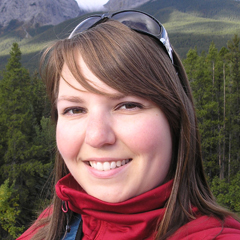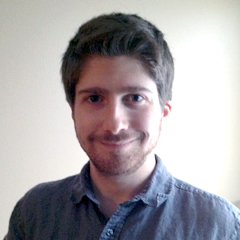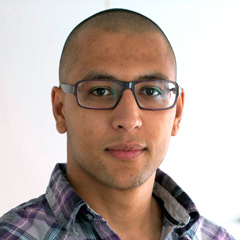Laureates of the 2013-2014 Vision network publication award
François Binet
Post-doc, Maisonneuve-Rosemont Hospital
Laboratory: Dr Przemyslaw (Mike) Sapieha
Binet F, Mawambo G, Sitaras N, Tetreault N, Lapalme E, Favret S, Cerani A, Leboeuf D, Tremblay S, Rezende F, Juan AM, Stahl A, Joyal JS, Milot E, Kaufman RJ, Guimond M, Kennedy TE, Sapieha P. Neuronal ER stress impedes myeloid-cell-induced vascular regeneration through IRE1α degradation of netrin-1. Cell Metab. 2013 Mar 5;17(3):353-71. doi: 10.1016/j.cmet.2013.02.003. PubMed PMID: 23473031.
My PhD training, done in the lab of Denis Girard at the INRS-Institut Armand-Frappier in Laval involved characterization of the mechanism of action of arsenic trioxide, a chemotherapeutic drug, on the neutrophil biology. I uncovered new proteins involved in the neutrophil reponse to arsenic trioxide, namely annexin-1 and the HSP89a as well as describing its pro-inflammatory effect in vitro. I also demonstrated that the ER stress pathways, until then uncharacterized in this cell type, could be activated following arsenic trioxide treatment and be responsible for its effect on the neutrophil. I then pursued my scientific formation as a postdoctoral researcher in the lab of Mike Sapieha at the Maisonneuve-Rosemont Research Center. There, I studied the potential role of neuronal guidance cues, namely semaphorin 3A and netrin-1, as targets for reparative angiogenesis in the retina. My work also led to the discovery of a crucial association between ER stress pathways and the formation of pathological vascular tufts that are characteristics of proliferative retinopathies (diabetic retinopathy and retinopathy of prematurity). Part of my work also focused on age-related macular degeneration and GPR91, the receptor for succinate. We found a surprising phenotype in the GPR91-/- KO mice that share many features of AMD, including outer retinal lesions, Bruch’s membrane thickening and accumulation of microglia in the subretinal space. Furthermore, analysis of human samples from a large data bank revealed a significant correlation between geographic atrophy and sequence variants in the GPR91 DNA sequence.
* * *
Bruno Cécyre
PhD candidate, vision sciences, École d’optométrie
Laboratory: Dr Christian Casanova and Dr Jean-François Bouchard
Cécyre B, Zabouri N, Huppé-Gourgues F, Bouchard JF, Casanova C. Roles of cannabinoid receptors type 1 and 2 on the retinal function of adult mice. Invest Ophthalmol Vis Sci. 2013 Dec 11;54(13):8079-90. doi: 10.1167/iovs.13-12514. PubMed PMID: 24255040.
Bruno Cécyre holds a bachelor degree in pharmacology from University of Sherbrooke and a master degree in visual sciences from University of Montreal. He will follow a PhD degree in visual sciences in the laboratories of Drs Jean-François Bouchard and Christian Casanova in January 2013. He is interested in the involvement of the endocannabinoid system in the visual system. When he was an undergraduate student, he completed two fellowships in the laboratory of Dr. Bouchard. There, he discovered a passion in the study of the endocannabinod system and vision. His master thesis focused on the expression and function of the endocannabinoid system in the rodent retina. The aim of his doctoral thesis is to evaluate the therapeutic potential of cannabinoids in some visual diseases.
* * *
Agustin Cerani
Master student, biochemistry and molecular medicine, Université de Montréal
Laboratory: Dr Przemyslaw (Mike) Sapieha
Cerani A, Tetreault N, Menard C, Lapalme E, Patel C, Sitaras N, Beaudoin F, Leboeuf D, De Guire V, Binet F, Dejda A, Rezende FA, Miloudi K, Sapieha P. Neuron-derived semaphorin 3A is an early inducer of vascular permeability in diabetic retinopathy via neuropilin-1. Cell Metab. 2013 Oct 1;18(4):505-18. doi: 10.1016/j.cmet.2013.09.003. PubMed PMID: 24093675.
I was born in Buenos Aires, Argentina, and immigrated to Canada in 2004. In Vancouver, BC, where I first lived, I pursued my undergraduate studies in Biological Sciences at Simon Fraser University (SFU). At SFU, I obtained my first research experience under the supervision of Dr. Gordon Rintoul and developed a great interest in the field of neuroscience while studying mitochondrial dynamics in neurons and astrocytes in the context of stroke. In 2010, I moved East to Montreal and joined Dr. Przemyslaw Sapieha ’s new laboratory at Hôpital Maisonneuve-Rosemont (HMR) in order to pursue graduate studies at the Department of Biochemistry and Molecular Medicine in the University of Montreal. In Dr. Sapieha’s lab, I studied the interaction of neurons and vessels in the pathophysiology of diabetic retinopathy. Through the study of one of the prevalent diabetic complications, I became increasingly interested in the epidemiological and clinical implications of diabetes. As a result, I am currently interested in complementing and expanding my experience in basic research to epidemiological research of diabetes and other chronic diseases.
* * *
Jennier Lake
PhD candidate, cell and molecular biology, Université Laval
Laboratory: Dr Sylvain Guérin
Lake J, Zaniolo K, Gaudreault M, Carrier P, Deschambault A, Bazin R, Germain L, Salesse C, Guérin SL. Expression of the α5 integrin gene in corneal epithelial cells cultured on tissue-engineered human extracellular matrices. Biomaterials. 2013 Sep;34(27):6367-76. doi: 10.1016/j.biomaterials.2013.05.007. Epub 2013 May 30. PubMed PMID: 23727260.
I hold a bachelor degree in biology and a certificate in biotechnology from Laval University. I contributed to basic research by several manners with my diverse trainings and jobs associated to both the molecular/cellular biology and biotechnology domains. In 2001, I contributed to a research project on the phenobarbital regulation of cytochromes P450 genes during my courses Research Initiation I-II in the molecular biology program under the supervision of Dr Alan Anderson. In 2002, I collaborated at a research project on the roles of keratins in stress response of hepatocytes under the supervision of Dr Normand Marceau. In 2003, I worked on Dr Jean Bérubé’s research project on the identification and classification of various Armillaria species. In 2004, I completed a master degree in animal science at Laval University under the supervision of Dr Grant Vandenberg with the project: Towards a new approach to establish the nutritional needs (such as phosphorus requirements) for rainbow trout (Oncorhynchus mykiss) using microarrays analyses. In 2007, I joined Dr Louis Bernatchez’s laboratory as a research assistant. I was in charge of following expression of four genes in the white muscle and the liver of coregonine fish by qPCR analyses and making comparison of gene expression profiles in the white muscle between normal and dwarf coregonine fish and between dwarf backcross with normal backcross coregonine fish. In 2008, I began a PhD program in cellular and molecular biology at Laval University in the laboratories of Dr Sylvain Guérin. His research project whishes to evaluate the influence of various components from the extracellular matrix on the expression of the α5 subunit integrin gene from the α5β1 integrin in corneal epithelial cells during corneal wound healing. To pursue my work, I received a master’s scholarships from the Natural Sciences and Engineering Research Council of Canada (NSERC) and a Frederick Banting and Charles Best Canada Graduate Scholarships Doctoral Awards from Canadian Institutes of Health Research (CIHR).
* * *
Joëlle Lavoie
PhD candidate, neurobioloy, Université Laval
Laboratory: Dr Marc Hébert
Lavoie J, Hébert M, Beaulieu JM. Glycogen Synthase Kinase-3 Overexpression Replicates Electroretinogram Anomalies of Offspring at High Genetic Risk for Schizophrenia and Bipolar Disorder. Biol Psychiatry. 2013 Oct 16. pii: S0006-3223(13)00827-5. doi: 10.1016/j.biopsych.2013.08.035. [Epub ahead of print] PubMed PMID: 24138923.
Joëlle Lavoie studied in medical biology at the Université du Québec à Trois-Rivières. In 2008, she began a Master degree in neurobiology at Laval University supervised by Marc Hébert and Martin Beaulieu and she transferred to a Ph.D. in 2009. Her researches focus on the electroretinogram (ERG) as a biomarker of psychiatric disorders. She studies the origins of the ERG anomalies reported in patients with psychiatric disorders and she works with patients and animal models. Joëlle is granted by research fellowships from the Fonds de recherche du Québec – Santé (FRQS), the Centre de recherche sur le cerveau, le comportement et la neuropsychiatrie (CRCN) and the Canadian Federation of University Women. She presented her work in several scientific events and international conferences where she received many awards and distinctions from the Association for Research in Vision and Ophthalmology (ARVO), the International Society for Clinical Electrophysiology of Vision (ISCEV) and the Vision Research Network. In her work published in the prestigious journal Biological Psychiatry, she demonstrates an association between the ERG amplitude and the expression of glycogen synthase kinse-3 (GSK3) which is a risk factor for several psychiatric illnesses. This suggests that changes in GSK3 expression may explain some ERG anomalies observed in children at high genetic risk for psychiatric disorders and in patients, thus supporting the biological validity of ERG measurements as a valuable biomarker for psychiatric research.
* * *
Renaud Manuguerra-Gagné
PhD candidate, bio-medical sciences, Université de Montréal
Laboratory: Drs Mark Lesk and Denis-Claude Roy
Manuguerra-Gagné R, Boulos PR, Ammar A, Leblond FA, Krosl G, Pichette V, Lesk MR, Roy DC. Transplantation of mesenchymal stem cells promotes tissue regeneration in a glaucoma model through laser-induced paracrine factor secretion and progenitor cell recruitment. Stem Cells. 2013 Jun;31(6):1136-48. doi: 10.1002/stem.1364. PubMed PMID: 23495088.
When I entered university, I developed a strong interest for research and more specifically for cell development. Understanding the mechanisms allowing a stem cell to generate progenitors capable of so many distinct roles has always been a great source of interest for me. That is why I started my Ph.D in a project born from the collaboration between the labs of Dr Mark Lesk, ophthalmologist and glaucoma specialist, and Dr Denis-Claude Roy, hemato-oncologist and specialist in bone marrow stem cells. My work, published in 2013 in Stem Cells, demonstrated that bone marrow mesenchymal stem cells are capable of restoring the function of damaged ocular tissues responsible for the development of glaucoma. This is an important discovery demonstrating that it is possible to reactivate dormant regenerative capacities in an organ that does not normally heal. These encouraging results allowed me to present in national (Stem Cell Network Annual General Meeting in 2008 and 2010, Rencontre annuelle générale du réseau ThéCell in 2010, 2011 and 2013, Till and Mcculloch meeting in 2012, Rencontre annuelle du réseau vision in 2013) and international (Association for Research in Vision and Opthalmology and International Society for Stem Cell Research in 2009 et 2012) congresses, in addition to winning many presentation awards.
* * *
Hocine Slimani
PhD candidate, vision sciences, École d’optométrie
Laboratory: Dr Maurice Ptito
Slimani H, Danti S, Ricciardi E, Pietrini P, Ptito M, Kupers R. Hypersensitivity to pain in congenital blindness. Pain. 2013 Oct;154(10):1973-8. doi: 10.1016/j.pain.2013.05.036. PubMed PMID: 24040972.
To follow up on my bachelor’s in Biomedical Sciences, I started a degree in Visual Sciences in 2010. As my interest in research was growing, I underwent an accelerated transition to PhD in 2011. I currently work under the direction of Dr Maurice Ptito, a professor recognized internationally for his work on brain plasticity and the understanding of the blind brain. His laboratory, the Harland Sanders Chair, is devoted exclusively to research on blind individuals and has the reputation of providing a high quality education to his students. Dr Ptito works closely with Dr Ron Kupers from Panum Institute, University of Copenhagen and Dr Pietro Pietrini from the University of Pisa. I had the chance to accompany Dr. Ptito several times in Copenhagen and Pisa for research internships during which I started my PhD project and have gained expertise in the use of sophisticated equipment that very few laboratories have at their disposal. During these internships, I had the opportunity to be mentored by experts in the fields of psychophysics and brain imaging. In addition, internships abroad represent unique opportunities to discover other ways of working, other research approaches and, to top it all, to build strong collaborations with laboratories working in the same direction as ours. Thus, the projects progress faster, are much deeper and therefore have a greater impact on the scientific world. Other foreign trips are planned for the coming years in order to better understand this unexplored topic of research that will have great implications on the understanding of blindness and the brain plasticity phenomena it entails.
